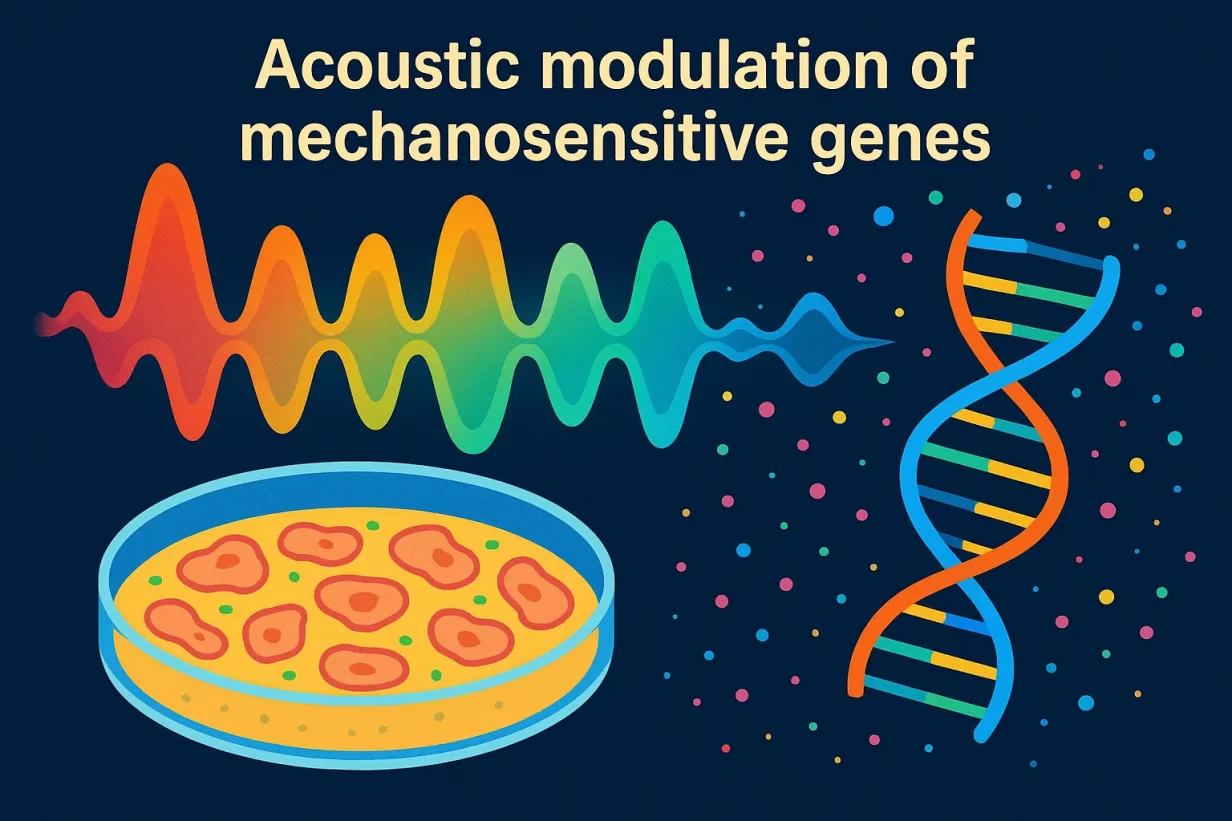
Sound Waves as Cellular Stimulators: Revolutionary Discovery Changes Our Understanding of Cell Biology
Living cells possess remarkable sensitivity to their environment, responding to various physical forces such as pressure, stretching, and compression. However, until recently, the impact of audible sound waves on cellular behavior remained largely unexplored. A groundbreaking study has now revealed that cells can detect and respond to acoustic stimulation in ways that could revolutionize biotechnology and regenerative medicine.
The Sound-Cell Connection: A New Frontier
Researchers have successfully demonstrated that acoustic waves within the audible range (20 Hz to 20 kHz) can directly influence cellular activities. Using a specialized sound emission system, scientists transmitted acoustic waves at frequencies of 440 Hz, 14 kHz, and broadband white noise to cultured mouse muscle cells (C2C12 myoblasts) at an intensity of 100 Pa.
The results were striking: after just 2 hours of acoustic exposure, 42 genes showed altered expression patterns, while 24 hours of stimulation affected 145 different genes. This cellular response demonstrates that sound waves function as legitimate biological stimulators, not merely background noise.
The Molecular Machinery Behind Sound Sensing
The research unveiled a sophisticated cellular mechanism for acoustic perception. When sound waves reach cells, they trigger a cascade of molecular events:
- Focal Adhesion Activation: Sound waves stimulate focal adhesions – structures that anchor cells to their surrounding matrix
- Kinase Phosphorylation: The focal adhesion kinase (FAK) becomes phosphorylated at position Y397, initiating signal transduction
- Gene Expression Changes: Key genes like Ptgs2/Cox-2 become activated, leading to prostaglandin E2 synthesis
- Cellular Morphology Shifts: Cells expand their adhesion area by 15-20% within one hour of acoustic stimulation
This pathway represents a novel form of mechanotransduction, where mechanical energy from sound waves converts into biochemical signals that alter cellular behavior.
Frequency Matters: Different Sounds, Different Responses
The study revealed that cells respond differently to various acoustic frequencies. Low-frequency sounds (440 Hz) generated more fluid movement in culture media, while high-frequency sounds (14 kHz) produced less flow but created unique hypoxic conditions. These frequency-specific responses suggest that cells possess sophisticated acoustic discrimination capabilities.
Interestingly, the research showed that early cellular responses (within 2 hours) were similar across different frequencies, while longer exposure periods (24 hours) revealed frequency-specific gene expression patterns. This temporal aspect indicates that cells process acoustic information through both immediate and delayed response mechanisms.
Cell Type Specificity: Not All Cells Are Equal Listeners
Different cell types exhibited varying degrees of acoustic sensitivity. Stromal cells, including fibroblasts, muscle precursors, and fat cell precursors (preadipocytes), demonstrated the highest responsiveness to sound stimulation. In contrast, epithelial cells and neuroblast cells showed relatively modest acoustic responses.
This cell-type specificity appears related to the structural properties of focal adhesions. Highly adhesive and motile cells, which maintain robust focal adhesion complexes, prove more sensitive to acoustic stimulation than less mobile cell types.
Practical Applications: Sound as a Therapeutic Tool
The most compelling application emerged in adipocyte (fat cell) research. When preadipocytes were exposed to continuous acoustic stimulation during their differentiation process, fat cell development became significantly suppressed. Specifically:
- Continuous 72-hour sound exposure reduced key fat cell markers (Cebpa and Pparg) to 18% and 26% of control levels
- Periodic 2-hour daily stimulation achieved approximately 30% suppression of these markers
- The proportion of undifferentiated cells increased from 23% to 39% under acoustic treatment
- Total lipid accumulation decreased by 13-15%
These effects matched those achieved by adding 1000 ng/ml of prostaglandin E2 directly to cell cultures, confirming the prostaglandin pathway’s central role in acoustic cellular responses.
Implications for Biotechnology and Medicine
This research opens unprecedented possibilities for acoustic-based cellular manipulation:
Tissue Engineering: Sound waves could provide non-invasive methods to control cell differentiation and tissue development without chemical additives or genetic modifications.
Regenerative Medicine: Acoustic stimulation might enhance healing processes by modulating cellular activities in damaged tissues.
Metabolic Research: The ability to suppress fat cell development using sound could lead to novel approaches for studying obesity and metabolic disorders.
Drug-Free Interventions: Acoustic therapy could offer alternatives to pharmaceutical interventions for conditions involving cellular dysfunction.
Technical Considerations and Future Directions
The research employed sophisticated measurement techniques to ensure accurate acoustic delivery. Sound intensity was measured directly in water using hydrophones, with pressure calculations confirming physiologically relevant levels. The custom-built PEEK (polyether ether ketone) diaphragm system minimized heat transfer while maximizing acoustic transmission efficiency.
Future investigations will likely explore:
- Optimal acoustic parameters for specific therapeutic outcomes
- Long-term effects of chronic acoustic exposure
- Combination therapies using sound waves with conventional treatments
- In vivo applications of acoustic cellular stimulation
A Paradigm Shift in Cell Biology
This discovery fundamentally alters our understanding of cellular environmental sensing. Sound, previously considered merely ambient energy, now emerges as a legitimate biological stimulus that cells actively process and respond to through dedicated molecular machinery.
The implications extend beyond laboratory applications. Since sound exists universally in natural environments, this research suggests that acoustic stimulation may play unrecognized roles in normal physiological processes. Organisms may have evolved to utilize ambient sound as environmental information for optimizing cellular activities.
As research continues, acoustic stimulation may become a standard tool in biological laboratories and clinical settings, offering precise, non-invasive methods for cellular control. This represents not just a technical advancement, but a conceptual revolution in how we understand the relationship between physical forces and living systems.
The intersection of acoustics and cell biology promises to yield innovative solutions for challenges in medicine, biotechnology, and our fundamental understanding of life itself.
